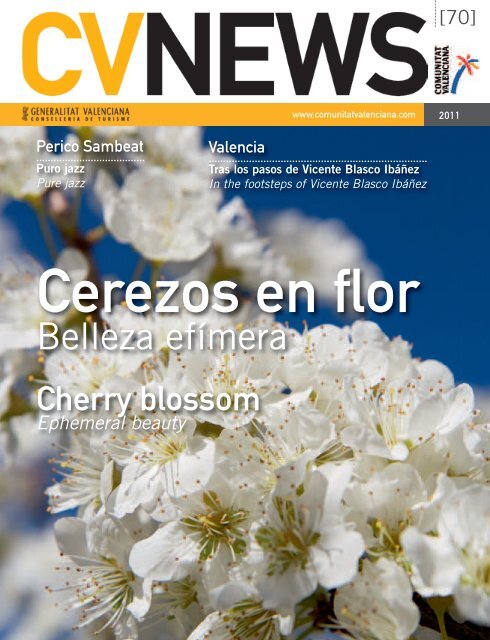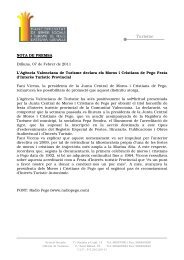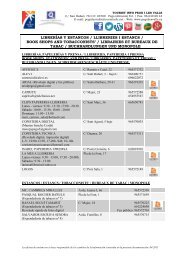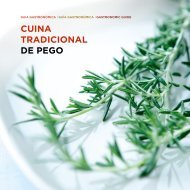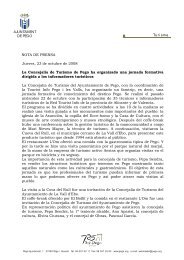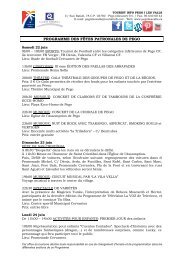Create successful ePaper yourself
Turn your PDF publications into a flip-book with our unique Google optimized e-Paper software.
[70]<br />
www.comunitatval<strong>en</strong>ciana.com 2011<br />
Perico Sambeat<br />
......................................<br />
Puro jazz<br />
Pure jazz<br />
Val<strong>en</strong>cia<br />
............................................................................<br />
Tras los pasos de Vic<strong>en</strong>te Blasco Ibáñez<br />
In the footsteps of Vic<strong>en</strong>te Blasco Ibáñez<br />
<strong>Cerezos</strong> <strong>en</strong> <strong>flor</strong><br />
Belleza efímera<br />
Cherry blossom<br />
Ephemeral beauty
<strong>Cerezos</strong> <strong>en</strong> <strong>flor</strong><br />
Cherry blossom
Nuestros destinos<br />
siempre vivos<br />
<strong>en</strong> el corazón del<br />
cerezo<br />
Our destinies live<br />
on in the heart of<br />
the cherry tree<br />
Matsuo Basho
LA RUTA DE LOS CEREZOS EN FLOR, EL ENCANTO DE LO EFÍMERO<br />
THE CHERRY BLOSSOM TRAIL, THE CHARM OF THE EPHEMERAL<br />
Matsuo Basho, una de las grandes figuras de la poesía japonesa de la era<br />
Edo, dedica este haiku a la <strong>flor</strong> del cerezo. Una <strong>flor</strong>, que <strong>en</strong> los valles de la<br />
montaña alicantina más cercanos al Mediterráneo, nace temerariam<strong>en</strong>te<br />
precoz <strong>en</strong> los albores de la primavera y que se vuelve tardía y mucho más<br />
tímida conforme se aleja del templado Mare Nostrum. Y es así, porque las<br />
últimas <strong>flor</strong>es esperan la templanza de mayo para completar su ciclo. Los<br />
cerezos de Alicante, casi un millón, trepan por los valles y por las laderas<br />
de los montes y se vist<strong>en</strong> fugazm<strong>en</strong>te de blanco <strong>en</strong> una de las<br />
manifestaciones más hermosas de la Naturaleza.<br />
Matsuo Basho, one of the great Japanese poets of the Edo period, dedicated<br />
this haiku to cherry blossom – a flower which, in the Mediterranean<br />
mountain valleys of Alicante, blooms precociously in the fledgling days of<br />
spring, delicate yet defiant, and becomes more timid and tardy the further<br />
it moves inland, where it will pati<strong>en</strong>tly await the milder days of May. There<br />
are almost a million cherry trees in Alicante, scaling the valleys and hillsides<br />
fleetingly dressed in white in one of the most beautiful displays of Nature.<br />
PEREGRINACIÓN<br />
..........................................................................<br />
Los valles y pueblos de la montaña de Alicante son<br />
esc<strong>en</strong>ario, cada año, de una peregrinación leg<strong>en</strong>daria<br />
que poco, o más bi<strong>en</strong> nada, ti<strong>en</strong>e que ver con la devoción<br />
y que coincide con el <strong>flor</strong>ecimi<strong>en</strong>to de los cerezos. Entre<br />
abril y mayo, la quieta <strong>flor</strong>esta rural de Agres, Alcocer<br />
de Planes, Alcoy, Alfafara, Almudaina, B<strong>en</strong>eixama,<br />
B<strong>en</strong>iarrés, B<strong>en</strong>illup, B<strong>en</strong>imarfull, Biar, Castalla,<br />
Coc<strong>en</strong>taina, Confrides, Quatretondeta, Gaianes, Gorga,<br />
Ibi, Xixona, L’Orxa, Mill<strong>en</strong>a, Muro de Alcoy, P<strong>en</strong>àguila,<br />
Planes, Tollos, La Vall d’Alcalá, La Vall d’Ebo, Vall de<br />
Gallinera, La Vall de Laguar y Vill<strong>en</strong>a <strong>en</strong> la provincia<br />
de Alicante y Bocair<strong>en</strong>t y Ontiny<strong>en</strong>t <strong>en</strong> la de Val<strong>en</strong>cia<br />
se vist<strong>en</strong> de blanco merced a la <strong>flor</strong>ación de los<br />
cerezos, un f<strong>en</strong>óm<strong>en</strong>o natural que no por esperado resulta<br />
m<strong>en</strong>os espectacular.<br />
Es precisam<strong>en</strong>te <strong>en</strong> ese mom<strong>en</strong>to cuando Les<br />
Valls –Gallinera, Alcalà, Ebo y Laguar- vertebrados por<br />
el río Girona, albergan un auténtico tesoro natural, <strong>flor</strong>ido<br />
<strong>en</strong> los albores de la primavera y vestido de rojo<br />
durante la recolección. Dos mom<strong>en</strong>tos cercanos y<br />
difer<strong>en</strong>tes <strong>en</strong> los que pasear por esos sil<strong>en</strong>ciosos<br />
campos, tan cercanos y desconocidos, se convierte<br />
<strong>en</strong> toda una experi<strong>en</strong>cia gratificante. Es cuando los<br />
peregrinos disfrutan primero de las <strong>flor</strong>es y luego de<br />
los frutos que cubr<strong>en</strong> los montes, es cuando se mira<br />
y admira un milagro que cada año se repite <strong>en</strong> un<br />
incesante ir y v<strong>en</strong>ir de la misma naturaleza.<br />
DESDE ASIA<br />
..........................................................................<br />
La cereza es una fruta originaria de Asia M<strong>en</strong>or pero<br />
que se cultiva hoy <strong>en</strong> día <strong>en</strong> una bu<strong>en</strong>a parte de las<br />
zonas templadas del planeta. Las producidas <strong>en</strong> la<br />
Comunitat Val<strong>en</strong>ciana se han convertido <strong>en</strong> unas de<br />
las más deliciosas y apreciadas.<br />
El cerezo es un árbol peculiar, de ramas dispersas<br />
que permit<strong>en</strong> que el sol le llegue por todas partes y<br />
la fruta madure por igual. La <strong>flor</strong>, que dura <strong>en</strong>tre diez<br />
y quince días, cae y de inmediato sale el fruto. La cereza<br />
es una fruta delicada, producto de la polinización cruzada<br />
gracias a las abejas. La alicantina es de dulzura<br />
extraordinaria, color int<strong>en</strong>so y aroma excepcional, se<br />
recolecta siempre <strong>en</strong> el punto justo de maduración<br />
<strong>en</strong>tre los meses de mayo y julio, porque la cereza es<br />
una fruta tan delicada que no admite cámaras<br />
frigoríficas, por eso la que hay se recolecta cuando<br />
toca y la que no, se pierde.<br />
Los productores de las cerezas de la montaña de<br />
Alicante, dulces, frescas y de textura firme y cruji<strong>en</strong>te,<br />
miman al detalle su fruto. Ellos han sabido mant<strong>en</strong>er<br />
el proceso de recolección artesanal y lo hac<strong>en</strong> a<br />
mano, fruto a fruto, de una <strong>en</strong> una, desgranándolas<br />
de las copiosas piñas que <strong>en</strong>galanan los cerezos y siempre<br />
<strong>en</strong> las horas más frescas del día para evitar la pérdida<br />
de su firmeza. Después se separan por variedad,<br />
color y tamaño para lograr la máxima paridad.<br />
Finalm<strong>en</strong>te se <strong>en</strong>vasan <strong>en</strong> recipi<strong>en</strong>tes nuevos e<br />
impolutos para asegurar su protección. De modo,<br />
que visto lo visto, es lógico que la cereza alicantina<br />
esté considerada como una de las mejores de España.<br />
LA LLEGADA DE LA PRIMAVERA<br />
..........................................................................<br />
El cerezo <strong>en</strong> <strong>flor</strong> es un símbolo del despertar de la<br />
naturaleza y <strong>en</strong> la Comunitat Val<strong>en</strong>ciana los árboles<br />
se preparan cada año a dar la bi<strong>en</strong>v<strong>en</strong>ida a la primavera<br />
con los sutiles matices de la <strong>flor</strong>es, desde Ontiny<strong>en</strong>t<br />
hasta Xixona y de La Vall de Laguar hasta Vill<strong>en</strong>a.<br />
La <strong>flor</strong>ación de los cerezos es variable, dep<strong>en</strong>de<br />
de muchos factores, pero principalm<strong>en</strong>te de la<br />
climatología. En ocasiones los cerezos <strong>flor</strong>ec<strong>en</strong> a<br />
finales del mes de marzo y <strong>en</strong> otras, esa <strong>flor</strong>esc<strong>en</strong>cia<br />
se produce bi<strong>en</strong> <strong>en</strong>trado el mes de abril. Aunque es<br />
imposible dar una fecha exacta merece la p<strong>en</strong>a estar<br />
at<strong>en</strong>to, porque cada año, cuando los montes y los valles<br />
se vist<strong>en</strong> de blanco, <strong>en</strong> uno de los f<strong>en</strong>óm<strong>en</strong>os más<br />
increíbles de la Naturaleza, vuelve a sorpr<strong>en</strong>der a propios<br />
y extraños.<br />
LA HUELLA ÁRABE<br />
..........................................................................<br />
Les Valls fue árabe durante mucho tiempo y aquellos<br />
leg<strong>en</strong>darios pobladores dejaron <strong>en</strong> ellos una huella<br />
indemne. El recorrido por campos y laderas pasa<br />
inexcusablem<strong>en</strong>te por L’Atzuvieta, un despoblado<br />
morisco rodeado de hermosos campos de <strong>flor</strong>idos<br />
cerezos. Siete casas construidas con piedra seca<br />
conforman el despoblado, cuyos muros son todavía<br />
capaces de mostrar la forma de vida e incluso la<br />
muerte de sus moradores. La excursión desde Pego<br />
por Les Valls para visitar los cerezos <strong>en</strong> <strong>flor</strong>, este año<br />
programada, si el tiempo lo permite, para abril por la<br />
empresa especializada <strong>en</strong> actividades turísticas<br />
complem<strong>en</strong>tarias Aestas, es un placer para los s<strong>en</strong>tidos.<br />
La vista disfruta del espectáculo de la <strong>flor</strong>ación, el oído<br />
del sonido de la suave brisa que llega del cercano<br />
Mediterráneo y el olfato del delicado aroma de las <strong>flor</strong>es.<br />
Y es que estos valles, uno de lugares más bellos y<br />
<strong>en</strong>igmáticos de la Comunitat Val<strong>en</strong>ciana, se conviert<strong>en</strong><br />
durante la <strong>flor</strong>ación <strong>en</strong> cercanos y accesibles.<br />
PILGRIMAGE<br />
..........................................................................<br />
Each year, the valleys and towns of the Alicante<br />
mountains are the focus of a leg<strong>en</strong>dary pilgrimage –<br />
secular yet spectacular – to admire the blossoming<br />
of the cherry trees. Across the months of April and<br />
May, the landscapes of literally doz<strong>en</strong>s of towns – Agres,<br />
Alcocer de Planes, Alcoy, Alfafara, Almudaina,<br />
B<strong>en</strong>eixama, B<strong>en</strong>iarrés, B<strong>en</strong>illup, B<strong>en</strong>imarfull, Biar,<br />
Castalla, Coc<strong>en</strong>taina, Confrides, Quatretondeta,<br />
Gaianes, Gorga, Ibi, Xixona, L’Orxa, Mill<strong>en</strong>a, Muro de<br />
Alcoy, P<strong>en</strong>àguila, Planes, Tollos, La Vall d’Alcalá, La<br />
Vall d’Ebo, Vall de Gallinera, La Vall de Laguar and<br />
Vill<strong>en</strong>a in the province of Alicante, and Bocair<strong>en</strong>t<br />
and Ontiny<strong>en</strong>t in the province of Val<strong>en</strong>cia – wake<br />
from their winter slumber in a spectacular show of white<br />
as the cherry trees burst into blossom as part of an<br />
eternal natural cycle which is anticipated yet nonetheless<br />
amazing.<br />
CVNEWS 12
La cereza de Alicante<br />
es una fruta exquisita y<br />
delicada, producto de<br />
la polinización cruzada<br />
gracias a las abejas<br />
Cross-pollinated by<br />
bees, Alicante cherries<br />
are delicate and<br />
delicious<br />
It is at precisely this time of year, early spring, wh<strong>en</strong><br />
the valleys of the river Girona – Gallinera, Alcalà, Ebo<br />
and Laguar – are at their blooming best. Yet soon, come<br />
harvest time, these same valleys will be respl<strong>en</strong>d<strong>en</strong>t<br />
in the rich red of ripe fruit, thereby providing our lay<br />
pilgrims with a double blessing: two differ<strong>en</strong>t but closely<br />
spaced periods in which to <strong>en</strong>joy a stroll through these<br />
sil<strong>en</strong>t fields, so close yet still secret and unknown –<br />
once to admire the blossom and th<strong>en</strong> again to feast<br />
on the fruit. All thanks to the miracle of Mother<br />
Nature and the <strong>en</strong>dless succession of the seasons.<br />
ASIAN ORIGIN<br />
..........................................................................<br />
Cherries originally came from Asia Minor but are<br />
now grown across a large part of the planet’s temperate<br />
areas, and the cherries grown in the Region of Val<strong>en</strong>cia<br />
are among the most sought after and delicious.<br />
Cherry trees are peculiar trees with dispersed<br />
branches to allow the sunlight to filter through and<br />
rip<strong>en</strong> all the fruit. Their blossom lasts from 10 to 15<br />
days before dropping, whereupon the fruit immediately<br />
begins to form. Cherries are a delicate fruit, the<br />
product of cross-pollination by bees, and the Alicante<br />
cherry is extraordinarily sweet, with a rich colour and<br />
exceptional aroma. They are always harvested at just<br />
the right mom<strong>en</strong>t of rip<strong>en</strong>ess as, being so delicate,<br />
they do not refrigerate well, so any fruit not harvested<br />
wh<strong>en</strong> it should be is therefore lost.<br />
The cherry producers in the Alicante mountains<br />
take painstaking care of their sweet, fresh, firm and<br />
crunchy fruit. They have maintained traditional<br />
harvesting methods, handpicking the cherries one by<br />
one during the coolest hours of the day to preserve<br />
their firmness. The fruit is th<strong>en</strong> sorted by variety, colour<br />
and size before being packaged into sterile new<br />
containers for maximum protection. Giv<strong>en</strong> all of this,<br />
it’s therefore no wonder that the Alicante cherry is<br />
considered to be one of the very best in Spain.<br />
THE ARRIVAL OF SPRINGTIME<br />
..........................................................................<br />
The blossoming cherry tree is a symbol of the<br />
reawak<strong>en</strong>ing of Nature, and in the Region of Val<strong>en</strong>cia<br />
the trees usher in the springtime each year with<br />
subtle shades of blossom from Ontiny<strong>en</strong>t to Xixona<br />
and La Vall de Laguar to Vill<strong>en</strong>a.<br />
The blossoming of the cherry tree is variable,<br />
dep<strong>en</strong>ding upon many factors but mostly upon climate.<br />
Sometimes the cherry trees flower at the <strong>en</strong>d of<br />
March, sometimes not until well into April – it’s<br />
impossible to give an exact date but it’s worth keeping<br />
an eye out, because wh<strong>en</strong> the mountains and the valleys<br />
are dressed in white, Nature’s glory provides a stunning<br />
sight which, year after year, never ceases to amaze.<br />
MOORISH LEGACY<br />
..........................................................................<br />
The Les Valls valleys were dominated by the Moors<br />
for many, many years, and these leg<strong>en</strong>dary people have<br />
left an <strong>en</strong>during legacy. No visit to the local fields and<br />
hillsides is complete without a trip to L’Atzuvieta, a<br />
deserted Moorish settlem<strong>en</strong>t surrounded by beautiful<br />
cherry orchards, where sev<strong>en</strong> dry-stone dwellings<br />
mutely testify to how their anci<strong>en</strong>t inhabitants lived<br />
and ev<strong>en</strong> died. The specialist complem<strong>en</strong>tary tour operator<br />
Aestas has scheduled an outing to Les Valls from Pego<br />
for the 3 rd April, weather permitting – the perfect time<br />
to admire the blossoming cherry trees, their delicate<br />
sc<strong>en</strong>t borne on the g<strong>en</strong>tle breeze of the nearby<br />
Mediterranean, and to explore these valleys, one of<br />
the most beautiful and <strong>en</strong>igmatic corners of the<br />
Region of Val<strong>en</strong>cia.<br />
TextText: Maica Botella<br />
Fotos/Photos: Javier Marina<br />
INFORMACIÓN<br />
INFORMATION<br />
Aestas<br />
C/ Del Marge, 24<br />
03792 Parc<strong>en</strong>t<br />
Tel. 966 405 020 / 667 523 604 /<br />
678 045 104<br />
www.aestas.es<br />
info@aestas.es<br />
Tourist Info Pego i Les Valls<br />
C/ San Rafael, 78<br />
03780 Pego<br />
Tel/Fax. +34 966 400 843<br />
www.pegoilesvalls.es<br />
pegoilesvalls@touristinfo.ne<br />
[i]<br />
INDICACIÓN GEOGRÁFICA PROTEGIDA<br />
PROTECTED GEOGRAPHICAL INDICATION<br />
El pot<strong>en</strong>cial de producción de la Indicación Geográfica<br />
Protegida, con más de un millón de árboles <strong>en</strong> producción,<br />
es de siete millones de kilos, aunque la cifra<br />
varía considerablem<strong>en</strong>te de unos años a otros, al ser<br />
un producto con una gran incid<strong>en</strong>cia climatológica.<br />
Burlat, Stark Hardy Geant, Bing, Van, Picota y Picota<br />
Ambrunesa son las principales variedades que se produc<strong>en</strong><br />
<strong>en</strong> la IGP Montaña de Alicante y cuya recolección,<br />
dep<strong>en</strong>di<strong>en</strong>do de los años, empieza <strong>en</strong> abril<br />
y acaba <strong>en</strong> julio.<br />
Las cerezas de la Montaña de Alicante se produc<strong>en</strong><br />
<strong>en</strong> secano con una mínima incid<strong>en</strong>cia de<br />
plagas y <strong>en</strong>fermedades. Además el manipulado artesanal,<br />
recolección y clasificación, también otorga un<br />
gran prestigio a la cereza alicantina. Las zonas productoras,<br />
con un microclima y un suelo óptimos para<br />
el cultivo, propician un sabor, un color y una firmeza<br />
excepcional, cualidades que los conviert<strong>en</strong> <strong>en</strong> unas<br />
de las más apreciadas por los consumidores españoles<br />
y europeos.<br />
With over a million trees in production, the cherry<br />
trees of the Protected Geographical Indication<br />
Montaña de Alicante yield some sev<strong>en</strong> million<br />
kilograms of cherries a year – a figure which varies<br />
considerably from year to year, dep<strong>en</strong>ding upon the<br />
weather. The main varieties cultivated under the<br />
protected Montaña de Alicante label are Burlat,<br />
Stark Hardy Geant, Bing, Van, Picota and Picota<br />
Ambrunesa, with harvesting g<strong>en</strong>erally comm<strong>en</strong>cing<br />
in April and running through to July.<br />
Montaña de Alicante cherries are grown upon<br />
unirrigated lands with a low incid<strong>en</strong>ce of pests and<br />
diseases, and the fact they are picked and sorted by<br />
hand adds to their prestige. Thanks to the local<br />
microclimate and optimal soil, these cherries have<br />
an exceptional flavour, colour and firmness, making<br />
them one of the most highly prized cherries among<br />
Spanish and European consumers.<br />
CVNEWS 13


